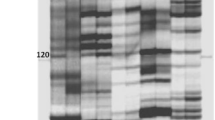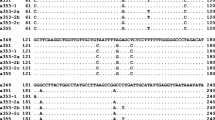Abstract
‘SI1300’ is a self-incompatible Brassica napus line generated by introgressing an S haplotype from B. rapa ‘Xishuibai’ into a rapeseed cultivar ‘Huayou No. 1’. Five S-locus specific primer pairs were employed to develop cleaved amplified polymorphic sequences (CAPS) markers linked the S haplotype of ‘SI1300’. Two segregating populations (F2 and BC1) from the cross between ‘SI1300’ and self-compatible European spring cultivar ‘Defender’, were generated to verify the molecular markers. CAPS analysis revealed no desirable polymorphism between self-incompatible and self-compatible plants. Twenty primer pairs were designed based on the homology-based candidate gene method, and six dominant sequence characterized amplified region (SCAR) markers linked with the S-locus were developed. Of the six markers, three were derived from the SRK and SP11 alleles of class II B. rapa S haplotypes and linked with S haplotype of ‘SI1300’. The other three markers were designed from the SLG-A10 and co-segregated with S haplotype of ‘Defender’. We successfully combined two pairs of them and characterized two multiplex PCR markers which could discriminate the homozygous and heterozygous genotypes. These markers were further validated in 24 F3 and 22 BC1F2 lines of ‘SI1300 × Defender’ and another two segregating populations from the cross ‘SI1300 × Yu No. 9’. Nucleotide sequences of fragments linked with S-locus of ‘SI1300’ showed 99% identity to B. rapa class II S-60 haplotype, and fragments from ‘Defender’ were 97% and 94% identical to SLG and SRK of B. rapa class I S-47 haplotype, respectively. ‘SI1300’ was considered to carry two class II S haplotypes and the S haplotype on the A-genome derived from B. rapa ‘Xishuibai’ determines the SI phenotype, while ‘Defender’ carry a class I S haplotype derived from B. rapa and a class II S haplotype from B. oleracea. SCAR markers developed in this study will be helpful for improving SI lines and accelerating marker-assisted selection process in rapeseed SI hybrid breeding program.





Similar content being viewed by others
References
Bateman AJ (1955) Self-incompatibility systems in angiosperms.III. Cruciferae Heredity 9:53–68
Brace J, Ockendon DJ, King GJ (1993) Development of a method for the identification of S alleles in Brassica oleracea based on digestion of PCR-amplified DNA with restriction endonucleases. Sex Plant Reprod 6:133–138
Brace J, King GJ, Ockendon DJ (1994) A molecular approach to the identification of S alleles in Brassica oleracea. Sex.Plant Reprod 7:203–208
Casselman AL, Vrebalov J, Conner JA, Singhal A, Giovannoni J, Nasrallah ME, Nasrallah JB (2000) Determining the physical limits of the Brassica S locus by recombinational analysis. Plant Cell 12:23–33
Chamberlain JS, Gibbs RA, Ranier JE, Nguyen PN, Caskey CT (1988) Deletion screening of the Duchenne muscular dystrophy locus via multiplex DNA amplification. Nucleic Acids Res. 16:11141–11156
Cui YH, Brugiere N, Jackman L, Si YM, Rothstein SJ (1999) Structural and transcriptional comparative analysis of the S locus regions in two self-incompatible Brassica napus lines. Plant Cell 11:2217–2231
de Nettancourt D (2001) Incompatibility and incongruity in wild and cultivated plants, 2nd edn. Springer-Verlag, Berlin, pp 1–332
Doyle JJ, Doyle JL (1990) Isolation of plant DNA from fresh tissue. Focus 12:13–15
Ekuere UU, Parkin IAP, Bowmann C, Marshall D, Lydiate DJ (2004) Latent S alleles are widespread in cultivated self-compatible Brassica napus. Genome 42:257–265
Esch E (1994) Untersuchungen zur Selbstinkompatibilität bei Brassica napus L. im Hinblick auf die Züchtung von Hybridsorten. Dissertation. Universität Hannover, Germany
Fu TD, Liu HL (1975) Preliminary report on the breeding of self-incompatible lines of Brassica napus. Oil Crops China 4:77–85
Fu TD, Yang XN, Yang GS, Ma CZ (1995) Heterosis breeding of self-incompatibility in Brassica napus. Proc 9th Int Rapeseed Congr 1:86–88
Fujimoto R, Okazaki K, Fukai E, Kusaba M, Nishio T (2006) Comparison of the genome structure of the self-incompatibility (S) locus in interspecific pairs of S haplotypes. Genetics 173(2):1157–67
Fukai E, Fujimoto R, Nishio T (2003) Genomic organization of the S core region and the S flanking regions of a class-II S haplotype in Brassica rapa. Mol Gen Genomics 269:361–369
Gertz A (1991) Breeding hybrid varieties in oilseed rape (Brassica napus) using self-incompatibility. Proc 8th Int Rapeseed Congr, Saskatoon, Canada, pp 113–116
Goring DR, Banks P, Baszczynski CL, Beversdorf WD, Rothstein SJ (1992) Use of the polymerase chain reaction to isolate an S-locus glycoprotein cDNA introgressed from B.campestris into B.napus ssp.oleifera. Mol Gen Genet 234:185–192
Goring DR, Glavin TL, Schafer U, Rothstein SJ (1993) An S receptor kinase gene in self-compatible Brassica napus has a 1-bp deletion. Plant Cell 5:531–539
Gowers S (1989) Self-incompatibility interactions in Brassica napus. Euphytica 42:99–103
Henegariu O, Heerema NA, Dlouhy SR (1997) Multiplex PCR: critical parameters and step-by-step protocol. Biol Tech 23:504–511
Li JM, Song Y, Chen LJ, Yang YH, Xu HJ, Fen LX, Zhang Z, Zhou YJ (2005) Simultaneous identification of multi-genes with resistance to root-knot nematode and tomato mosaic virus respectively by multiplex PCR markers in Tomato. J Agric Biotechnol 13(6):698–702
Liu HL, Fu TD, Yang XN, Wu JS (1981) Preliminary report on the breeding of the maintainer lines and restoring lines of self-incompatible lines in Brassica napus. J Huazhong Agricultural Univ 3:9–28
Ma CZ, Fu TD, Yang GS, Tu JX, Yang XN, Dan F (1998) Breeding for self-incompatibility lines with double-zero on Brassica napus L. J Huazhong Agricultural University 17(3):211–213
MacKay GR (1977) The introgression of S-alleles into forage rape, Brassica napus L. from turnip, Brassica campestris L. ssp. rapifera. Euphytica 26:511–519
Möhring S, Horstmann V, Esch E (2005) Development of a molecular CAPS marker for the self-incompatibility locus in Brassica napus and identification of different S alleles. Plant Breed 124:105–110
Nasrallah ME, Wallace DH (1967) Immunogenetics of selfincompatibility in Brassica oleracea. Heredity 22:519–527
Nasrallah JB, Kao TH, Goldberg ML, Nasrallah ME (1985) A cDNA clone encoding an S-locus specific glycoprotein from Brassica oleracea. Nature 318:263–267
Nasrallah JB, Nishio T, Nasrallah ME (1991) The self-incompatibility genes of Brassica: expression and the use in genetic ablation of floral tissues. Annu Rev Plant Physiol Plant Mol Biol 42:393–422
Nasrallah JB, Nasrallah ME (1993) Pollen-stigma signaling in the sporophytic self-incompatibility response. Plant Cell 5:1325–1335
Nishio T, Kusaba M, Watanabe M, Hinata K (1996) Registration of S alleles in Brassica campestris L by the restriction fragment sizes of SLGs. Theor Appl Genet 92:388–394
Nishio T, Kusaba M, Sakamoto K, Ockendon DJ (1997) Polymorphism of the kinase domain of the S-locus receptor kinase gene (SRK) in Brassica oleracea L. Theor Appl Genet 95:335–342
Nou IS, Watanabe M, Isogai A, Hinata K (1993) Comparison of S-alleles and S-glycoproteins between two wild populations of Brassica campestris in Turkey and Japan. Sex Plant Reprod 6:79–86
Ockendon DJ (1974) Distribution of self-incompatibility alleles and breeding structure of open-pollinated cultivars of Brussels sprouts. Heredity 33:159–171
Okamoto S, Odashima M, Fujimoto R, Sato Y, Kitashiba H, Nishio T (2007) Self-compatibility in Brassica napus is caused by independent mutations in S-locus genes. Plant Journal 50:391–400
Parkin IAP, Sharpe AG, Keith DJ, Lydiate DJ (1995) Identification of the A and C genomes of amphidiploid Brassica napus (oilseed rape). Genome 38:1122–1131
Rahman MH (2005) Resynthesis of Brassica napus L. for self-incompatibility: self-incompatibility reaction, inheritance and breeding potential. Plant Breed 124:13–19
Sakamoto K, Kusaba M, Nishio T (2000) Single-seed PCR-RFLP analysis for the identification of F1 hybrid cultivars of broccoli and cabbage. Plant Cell Rep 19:400–406
Sato K, Nishio T, Kimura R, Kusaba M, Suzuki T, Hatakeyama K, Ockendon D, Satta Y (2002) Co-evolution of the S-locus genes, SRK, SLG and SP11/SCR, in Brassica oleracea and Brassica rapa. Genetics 162:931–940
Sato Y, Sato K, Nishio T (2006) Interspecific pairs of class II S haplotypes having different recognition specificities between Brassica oleracea and Brassica rapa. Plant Cell Physiol 47:340–345
Schopfer CR, Nasrallah M, Nasrallah JB (1999) The male determinant of self-incompatibility in Brassica. Science 286:1697–1700
Shiba H, Takayama S, Iwano M, Shimosato H, Funato M, Nakagawa T, Che FS, Suzuki G, Watanabe M, Hinata K, Isogai A (2001) A pollen coat protein, SP11, determines the pollen S-specificity in the self-incompatibility of Brassica species. Plant Physiol 125:2095–2103
Silva NF, Stone SL, Christie LN, Sulaman W, Nazarian KAP (2001) Expression of the S receptor kinase in self-compatible Brassica napus cv. Westar leads to the allelespecific rejection of self-incompatible Brassica napus pollen. Mol Genet Genomics 265:552–559
Stein JC, Howlett B, Boyes DC, Nasrallah ME, Nasrallah JB (1991) Molecular cloning of a putative receptor protein kinase gene encoded at the self-incompatibility locus of Brassica oleracea. Proc Natl Acad Sci USA 88:8816–8820
Suzuki G, Kai N, Hirose T, Fukui K, Nishio T, Takayama T, Isogai A, Watanabe M, Hinata K (1999) Genomic organization of the S-locus: identification and characterization of genes in SLG/SRK region of an S9 haplotype of Brassica campestris (syn. rapa). Genetics 152:391–400
Takasaki T, Hatakeyama K, Suzuki G,Watanabe M, Isogai A, Hinata K (2000) The S receptor kinase determines self-incompatibility in Brassica stigma. Nature 403:913–916
Thompson JD, Gibson TJ, Plewniak F, Jeanmougin F, Higgins DG (1997) The Clustal X windows interface: flexible strategies for multiple sequence alignment aided by quality analysis tools. Nucleic Acids Res 25:4876–4882
Yang GS, Chen CB, Zhou GL, Geng CN, Ma CZ, Tu JX, Fu TD (2001) Genetic analysis of four self-incompatible lines in Brassica napus. Plant Breed 120:57–61
Acknowledgements
The authors are grateful to Wallace Cowling of the University of Western Australia, and several anonymous reviewers, for helpful suggestions in revising the manuscript. This research was financed by funds from the National Key Basic Research Special Foundation of China (2007CB1090) and supported by the Program for Changjiang Scholar and Innovative Research Team in University (IRT0442).
Author information
Authors and Affiliations
Corresponding author
Rights and permissions
About this article
Cite this article
Zhang, X., Ma, C., Fu, T. et al. Development of SCAR markers linked to self-incompatibility in Brassica napus L.. Mol Breeding 21, 305–315 (2008). https://doi.org/10.1007/s11032-007-9130-x
Received:
Accepted:
Published:
Issue Date:
DOI: https://doi.org/10.1007/s11032-007-9130-x




